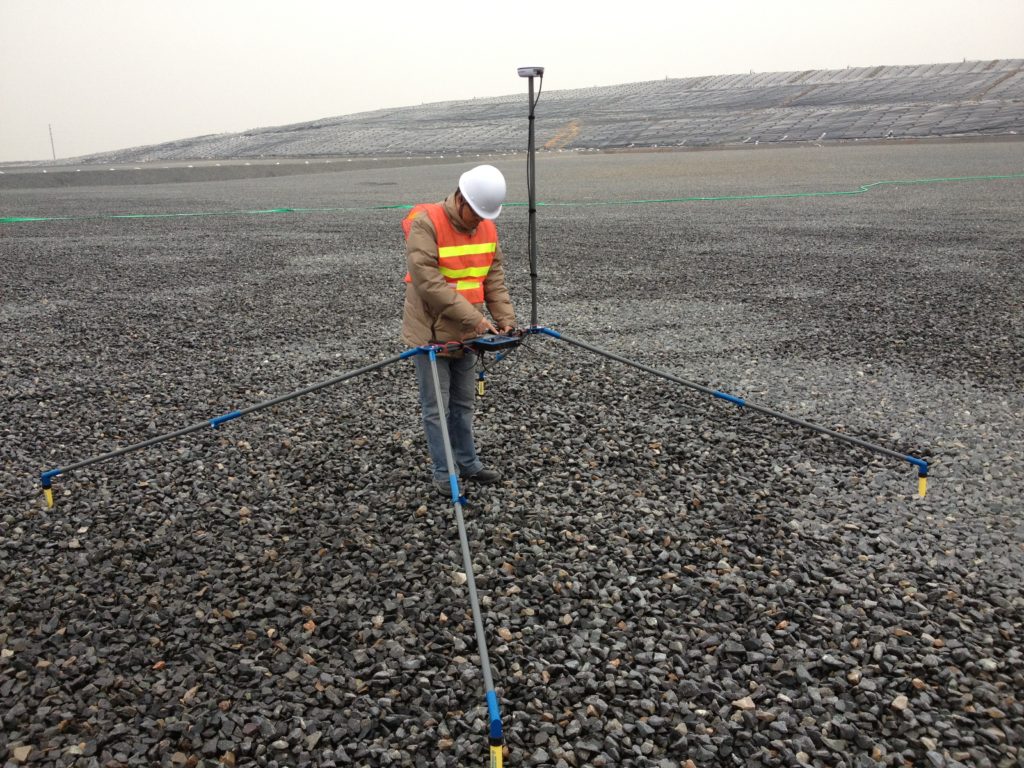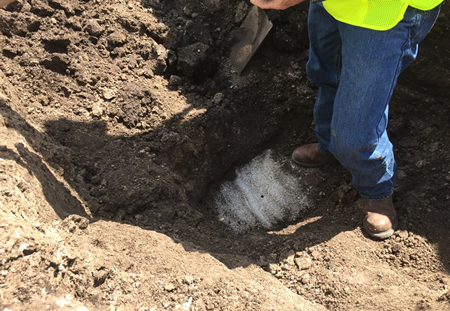
By Abigail Beck, P.E. – Electrical Leak Location (ELL) survey success is directly related to the sensitivity that can be achieved by the method employed. Method sensitivity is one of the most widely misunderstood aspects of ELL surveys, since it is largely a function of site conditions and less a function of survey equipment and methodology. Some adjustments in ELL equipment and survey methodology can be made to slightly increase survey sensitivity, but poor site conditions that cannot be practically remedied pose the largest barrier to achieving a desired level of method sensitivity.
The various leak location methods feature different levels of sensitivity expressed in terms of the smallest detectable leak. The actual sensitivity varies and is largely dependent on site conditions. The sensitivity of the bare geomembrane methods is extremely reliable, since the equipment is typically capable of finding smaller holes than the 1mm diameter specified minimum detectable size.
Other than the presence of poor contact conditions between the geomembrane and the subgrade (wrinkles, bridging), the sensitivity should be the same throughout the survey area as long as the subgrade is sufficiently conductive throughout.
The dipole method, used to locate leaks after installation of the cover material or while an impoundment is filled with water, is a completely different story. This article focuses on the soil-covered dipole method.
ISOLATING A LEAK – DIPOLE METHOD

The site conditions that affect survey sensitivity for the dipole method include subgrade and cover material conductivity, hole contact, and survey area isolation. Adjustments can be made with the survey equipment and methodology to compensate for poor material conductivity up to a point, but if a hole does not have sufficient contact it will not be detectable.
Sufficient contact is created by moisture or soil filling the void in the geomembrane created by the hole. Isolation of the survey area means that the cover material is isolated from the subgrade material everywhere except where there may be leaks.
For the dipole method, a current injector electrode is placed in the cover material and a current return electrode is placed in the subgrade material. Since electricity flow always follows the path of least resistance, all potential electrical paths must be removed so that the electricity will only flow through the leaks within the survey area. Otherwise, the leaks may not draw enough current to be detectable.
Survey area isolation is typically achieved by leaving a strip of geomembrane exposed around the entire survey area and removing any access roads that can conduct current out of the survey area. A geotexile cushion can be left in place in the isolation trench, but if it gets wet then isolation will be compromised.
A COMMON MISCONCEPTION
It is a common misconception that applying a dipole method survey for soil-covered geomembranes will locate all leaks in the geomembrane. However, the smallest damage such as pinholes and knife slices during installation should be found using one of the bare geomembrane methods before cover material placement. The soil-covered dipole method may only locate leaks as small as ¼” in diameter, but with poor site conditions even this level of sensitivity is difficult to achieve.
In addition, excessive leaks in the geomembrane will compromise the sensitivity of the entire survey area. It is documented in the ASTM that leaks can mask the presence of other nearby leaks, so each leak must be uncovered and isolated from the cover soil and the area around it resurveyed to check for any nearby leaks.
This same principal can apply to the entire survey area as well if the leak or leaks are large enough. If the only leaks present in a geomembrane are very small, then they have a good chance of being detected as long as the holes have good contact with the cover material. However, those same leaks may not be detected if there are much larger damage locations elsewhere in the survey area.
ZEROING IN ON THE PROBLEM
To illustrate this point, one small survey area contained multiple holes. On first review of the data from the entire area, four anomalies were clearly visible with strong leak signatures and one anomaly exhibited the shape of a leak signature but the signal was too weak to locate the leak on closer inspection around the anomaly. The four larger leaks were then uncovered and isolated from the cover material. The fifth anomaly located by the data was then rechecked. The leak signature was very strong and the leak was easily pinpointed. The entire survey area was then resurveyed and one leak location showed up very prominently in the data. A review of this same location during the first survey had revealed no indication of an anomaly. When this last leak was excavated, it was a ½” diameter leak, which was significantly smaller than the other leaks located.
A practical way to enhance the dipole method sensitivity is to review the voltage data from the entire survey area, then pinpoint the leak locations starting with the largest anomalies and proceeding to the smaller anomalies. By the time the smallest anomalies are checked, the larger leaks will have been removed from the survey area, enhancing the sensitivity. Still, if there are too many large damage locations, the smaller leaks may not show up in the data during the first survey, as the previous example showed.
SOLID SCIENCE
Though the dipole method may seem like magic at times, there is a solid science to it. There must be sufficient electrical conductivity through any leak locations in order for detection, and current will always flow through the path of least resistance, potentially bypassing the holes we hope to find if there is an easier path for the current to take. One small access road or one thin film of liquid along the perimeter of the survey area can and will compromise the survey sensitivity.
Additionally, a bare geomembrane survey should be performed before cover soil placement.
It sometimes takes the cooperation of everyone involved in a project to ensure that the methods are used to their full potential with maximum sensitivity, but when they are it is well worth the effort and it is possible to locate all leaks in an installed geomembrane.
**
Abigail Beck is the Director of TRI Liner Integrity Services, a division of TRI Environmental. For information on the company’s survey training and education, or to inquire about purchasing or renting liner survey equipment, visit www.linersurvey.net or contact abeck@tri-env.com.
SEE ALSO











